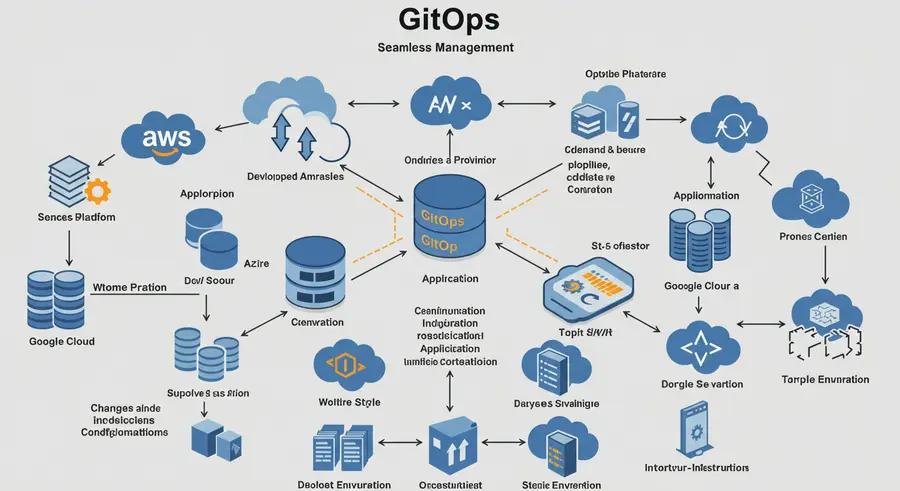Multi-Cloud & Hybrid GitOps: Unifying Your Deployment Strategy

In today's complex technological landscape, organizations often operate across multiple cloud providers (multi-cloud) and even integrate their on-premise infrastructure with public clouds (hybrid cloud). This distributed environment presents unique challenges for consistent application deployment, configuration management, and operational efficiency. This is where the power of GitOps truly shines, offering a unified and automated approach to manage diverse environments from a single source of truth: Git.
Why Multi-Cloud and Hybrid GitOps?
The motivations for adopting a multi-cloud or hybrid strategy are varied, ranging from avoiding vendor lock-in, ensuring business continuity, leveraging specialized services from different providers, to meeting data residency requirements. However, managing these disparate environments manually or with fragmented tools can lead to inconsistencies, operational overhead, and increased risk.
GitOps addresses these challenges by:
- Standardizing Deployments: Define your infrastructure and application configurations in Git, ensuring consistency regardless of the target environment.
- Centralized Control: Manage all your environments from a single Git repository, simplifying auditing and change tracking.
- Automated Reconciliation: GitOps operators continuously monitor the state of your clusters and reconcile them with the desired state defined in Git, automating deployments and rollbacks.
- Enhanced Security and Compliance: Git provides a robust audit trail, and policies can be codified and enforced, improving overall security posture.
Key Principles for Success
Implementing GitOps effectively in a multi-cloud or hybrid setup requires adherence to certain principles:
- Unified Repository Structure: Design your Git repository to logically separate configurations for different environments (e.g., `clusters/aws/prod`, `clusters/azure/dev`, `on-prem/staging`).
- Environment-Specific Overlays: Utilize tools like Kustomize or Helm to manage environment-specific configurations (e.g., resource limits, replica counts, ingress rules) without duplicating base manifests.
- Policy as Code: Implement policies for security, compliance, and governance directly in Git using tools like OPA (Open Policy Agent) to ensure consistent enforcement across all environments.
- Observability Across Clouds: Establish a robust observability stack that can aggregate metrics, logs, and traces from all your clusters, providing a holistic view of your distributed systems.
- Network Connectivity and Security: Plan for secure and reliable network connectivity between your GitOps controllers, Git repositories, and target clusters, especially in hybrid scenarios.
Tools and Technologies
Several tools facilitate Multi-Cloud and Hybrid GitOps:
- Argo CD / Flux CD: These are popular GitOps continuous delivery tools that can manage deployments to multiple Kubernetes clusters, regardless of their underlying cloud provider or on-premise location.
- Cluster API: For managing the lifecycle of Kubernetes clusters themselves across different infrastructure providers in a GitOps-native way.
- Crossplane: Extends Kubernetes to manage external infrastructure resources (like databases, message queues, and load balancers) across multiple clouds, all through Git.
- Terraform / Pulumi: While not strictly GitOps tools, they are essential for provisioning the underlying infrastructure in a reproducible manner, which then becomes the target for GitOps deployments.
Challenges and Considerations
While powerful, Multi-Cloud and Hybrid GitOps come with their own set of challenges:
- Complexity of Configuration: Managing variations across different cloud providers can become complex. Careful planning of repository structure and overlay strategies is crucial.
- Networking and Security: Ensuring secure and efficient communication across disparate networks requires careful design.
- Observability Silos: Preventing fragmented visibility requires a unified monitoring and logging strategy.
- Data Gravity: Data movement and locality can be a significant concern, especially in hybrid scenarios.
The Future is Unified
As organizations continue to embrace distributed architectures, GitOps provides the foundational methodology to bring order and automation to the chaos of multi-cloud and hybrid environments. By treating your entire infrastructure and application state as code in Git, you can achieve unprecedented levels of consistency, reliability, and security. This unified approach simplifies operations and allows teams to focus on innovation rather than manual configurations. For those who dive deep into market trends and the strategic allocation of resources across diverse investment landscapes, having advanced tools for financial research becomes invaluable.
Back to Home